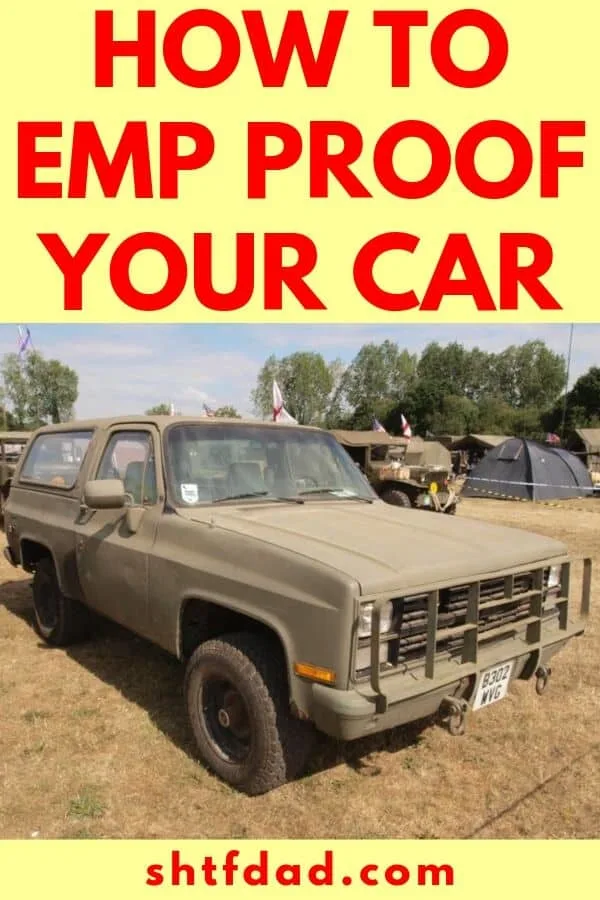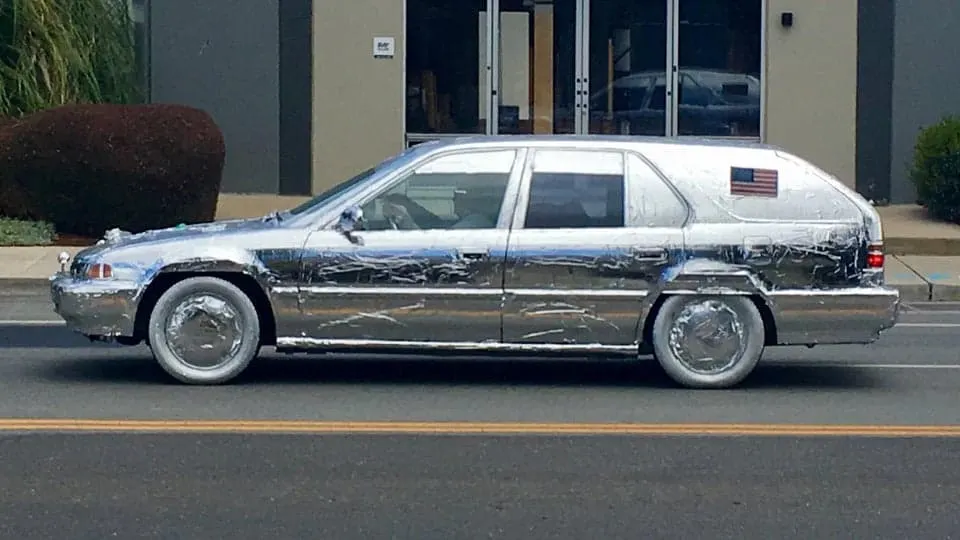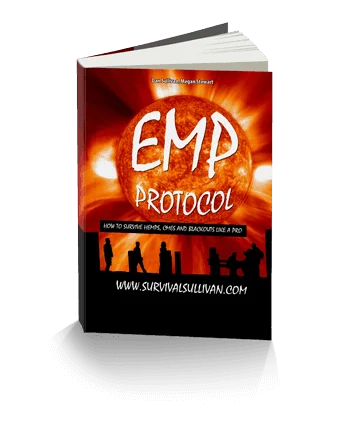SHTFDad may collect a share of sales or other compensation from the links on this page.
Should you make an EMP proof car?
Rising tensions with North Korea and other nuclear countries might have you wondering if you should be investing in a bomb shelter or more.
The threat of nuclear war doesn’t just bring worries about explosions and nuclear fallout. There is also the problem of the electromagnetic pulse, or “EMP”, that the bombs release when they detonate.
We rely on electronic devices for both work and play. Our cars run on high-end electronics, too.
Even without a nuclear blast behind it, a targeted EMP could effectively knock us back to the Stone Age. This would and leave anyone with a modern car stranded where they parked.
How can you make an EMP proof car?
Follow these easy step-by-step instructions to help you ensure you’ll be ready if the worst ever happens.
What is an ElectroMagnetic Pulse (EMP)?

An electromagnetic pulse can be caused by a nuclear strike or by an EMP generator. An EMP can also come from our friendly neighbor, the sun, via a coronal mass ejection (“CME”).
The result is the same regardless of the source of the pulse. Any exposed electronics will be shorted out and destroyed. This means your car, your computer, your phone and even electronic medical devices like implanted pacemakers and defibrillators will cease to function.
An EMP is broken down into three individual pulses, dubbed E1, E2, and E3.
E1
E1 pulses happen when the gamma radiation released by a nuclear detonation knocks electrons loose from the atoms in the atmosphere. This creates an enormous electrical current.
E2
E2 pulses are similar to the electromagnetic pulses produced by very close lightning strikes. They happen because of the inelastic gammas produced by the neutrinos within the nuclear weapon.
E3
E3’s happen because the force of the nuclear blast literally throws the planet’s magnetic field out of the way. In nature, E3’s are seen as the result of solar geomagnetic storms.
E1 and E2 pulses are what fry modern electronics, traveling along any exposed wires they can find. Now we know more about what makes up an EMP. How can we protect ourselves from it?
Choose the Right Vehicle
Your first step is to choose a vehicle to EMP proof. If you’ve got a car that was built in the last decade, chances are it won’t be useful if an EMP takes out all the electronics in your immediate vicinity.
Most new vehicles come equipped with more than 100 sensors and processors that will all get fried if you’re caught in an EMP.
The exact year, make and model you choose is up to you. You’ll want to avoid vehicles with electronics that control critical systems. That means no electronic fuel injection or electronic ignition. Also, no anti-lock brakes and no engine control module if you can avoid it.
If possible, the best option for an EMP proof car will be an older model that has as few electronic components as possible. Find something with a carburetor and a distributor instead of electronic fuel injection.
They’ll require a little bit more tinkering and won’t be as fuel-efficient as modern cars, but they’re easier to harden against the threat of an EMP.
We’ll get into that more in a moment. You can also work on these cars to improve your skills in that area as well, which is helpful if you breakdown.
Gas or Diesel?
Should you choose a gasoline vehicle for your EMP proof car, or one that runs on diesel?
This is a personal choice. However, keep one thing in mind: Both types of fuel will be difficult, if not impossible, to obtain after an EMP wipes out the local infrastructure. You can store both gasoline and diesel, but this is where things get tricky.
Both types of fuel will spoil and become unusable after a while. This leaves you with junk that’ll gum up your engine and leave you stranded as quickly as an EMP attack will.
The difference between the two is that one spoils faster than the other. Petroleum-based fuels spoil depending on how refined they are. Gasoline is refined more than diesel. You can slow down the spoilage of gasoline with a fuel stabilizer, but it will not last forever.
With diesel vehicles, you have the option to create biodiesel from organic waste. This gives you a near unlimited source of fuel while you wait for the restoration of the infrastructure.
EMP Variables
While a nuclear blast and its accompanying EMP can do a lot of damage. Whether or not the EMP takes your car offline depends on a lot of things, such as:
- Your distance from the point of detonation to where your car is parked
- Your direction to the height of the detonation
- The gamma-ray output of the explosion
Even the strength of the planet’s magnetic field in your exact location determines if your car is safe or if it gets fried. It’s hard to determine whether or not you’ll be affected by an EMP until it happens.
If you’re concerned about losing your only mode of transportation to an EMP, here are some steps to help you protect your ride.
EMP Protection For Cars
Other than trading in your daily driver for something built before 1986, what can you do to EMP proof your ride?
The nice thing about most cars is that they have steel frames and aluminum or steel bodies, making them portable Faraday cages. A Faraday cage protects electronics from the impact of an EMP by rerouting the dangerous electrical charge and keeping it away from anything stored within.
The problem with cars is that the cage isn’t complete. There are windows and things that the EMP can travel through. This reaches the sensitive electronics contained within.
One way to protect your car from EMP is to turn it into a complete Faraday cage. Cover any exposed area — windows, windshields, etc. — with aluminum foil to complete the circuit.
You can’t drive the car while it’s kitted out like this. However, you can always keep a spare vehicle wrapped in foil and stored in the garage.
In the Garage
Speaking of garages, if you don’t want to waste all your aluminum foil, you can turn your entire garage into a Faraday cage with some remodeling.
The problem is that most modern garages are wired for electricity. The lighting, electric garage door openers, and even outlets on the wall all serve as a conduit for an EMP to travel through the walls.
If you want to turn your garage into a Faraday cage, you’ll have to remove any possible transmission points for the pulse. That means no permanent lighting, no wires in the walls, and no electricity.
Remodeling your garage may not be an option. Keep backup parts handy in small, portable Faraday cages. That way, you can replace any electronics that might get fried.
You don’t have to spend a ton of money to protect your parts. A simple metal trash can might serve as a Faraday cage. Make sure it has a lid and your parts aren’t touching the metal inside the cage.
Wrap anything you want to store in cloth, and then in foil to protect each piece. Then store them inside the trash can. You’ll have to get your hands dirty to replace all the parts. If you set up your Faraday cage correctly, you should have a running vehicle again in no time.
Related: Check out our comprehensive list of the 50 critical things to EMP proof in the event of an EMP attack or a massive CME!
Getting Your Car Ready for Emergencies
Getting an EMP proof car is just the first step of your EMP protocol. If you’re worried about being able to transport yourself and your family during an emergency, you must take additional measures.
Make sure your car is in good working order. You don’t want it to break down the first time you try to take it off-road to get around a gridlock of abandoned vehicles.
Take the time to understand your engine. Know how it performs and do whatever is required to improve its performance and keep it running. This is another reason to pick an older model for your EMP proof car. They’re easier to work on if you can’t take your car to the mechanic when something breaks.
Opt for synthetic oils and additives to get the most out of even older engines. They’re designed to improve performance by cutting down on friction in the engine. Then it can run longer and harder without damaging the internal components.
Keep up with your regular maintenance as well, and if something starts going wrong, fix it as quickly as possible. You never know when a nuclear strike or EMP might occur. Don’t get caught unprepared.
Be Prepared for Anything
No one wants to think about nuclear war or the end of the world. Given the unrelenting EMP threat from countries like North Korea and Iran building their nuclear arsenals, or the sun sending a massive CME our way, we need to prepare.
The possibility of this kind of event is growing every year. Instead of getting stranded, take the time to EMP proof your car.
Or, pick up an older make and model that will be easier to protect or repair after a strike. The most important thing to remember is to be prepared for anything.
We never know when a nuclear strike or an electromagnetic pulse might send us back to the Stone Age. It’s better to be prepared — and then you won’t find yourself walking everywhere after the end of the world.

Frequently Asked Questions
What is the best vehicle to acquire to start my EMP proof motor pool?
Any vehicle with minimal electronics including carburetor and no computers are best to start with as they will be less susceptible to an EMP.
What fuel should I choose?
Diesel will store slightly longer than gasoline. Also, Diesel engines will also run on biodiesel.
Isn’t my car’s body already a Faraday Cage?
Yes, but it is an incomplete one. To complete it you must cover all gaps (like the windows) and seams (like the doors) with foil or foil tape.
What other items are necessary to prepare my car?
Maintaining your vehicle is task number 1. Keep the oil changed, all components properly maintained (greased, oiled, and clean) is the most important task to keep your vehicle in running order.
Make a Faraday Cage That Fits in your BOB
Unless you wrap your car completely in a seamless Faraday cage, that won’t allow you to actually go anywhere, you may not be able to protect all of your car’s components.
So Survival Sullivan came up with an easy Faraday cage that is lightweight and fits in your bug out bag, where you can store your sensitive electronic components easily.
In fact, they came up with one for your home or bug out location, that’s even more powerful. Make these two and never have to worry about an EMP again.
Dan Sullivan, one of the best prepping gurus out there, made this eye-opening video about EMPs. Lots of controversies surround the topic, but he’s setting things straight once and for all.
Hint: EMPs are about much more than Faraday cages. You need a bulletproof survival plan tailored to this specific event. Click here to see the two types of EMPs and why they’re likely to hit the U.S. at any time.
Resources:


